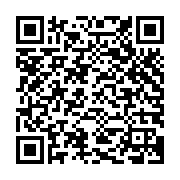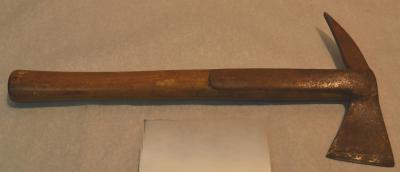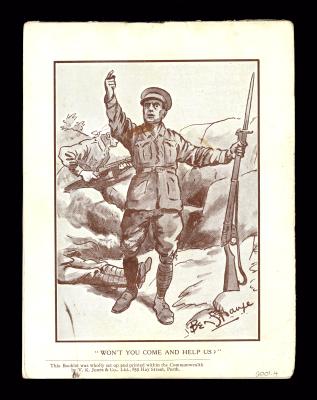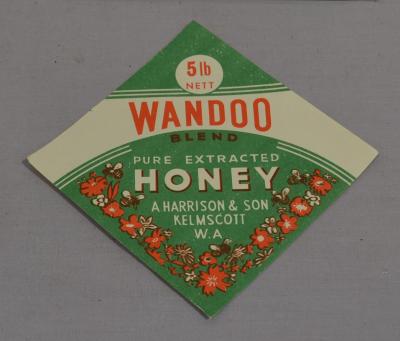CARTOON - THE DECIDING FACTOR
1919Scene of two men on a plank over a log forming a see-saw with [FEDERAL ELECTION] written along the outside edge. Standing on the fulcrum of the see-saw is a man in a military uniform rubbing his chin. On the up end of the see-saw is a caricature of Prime Minister William 'Billy' Hughes wearing an Australian Infantry Forces slouch hat and a suit. On the other end of the see-saw is a figure of a large man in a coat and cloth hat. Out the back of his pants is a piece of cloth with [RED / FLAG] written on it. Rural scene in background
Ben Strange signature bottom right corner
The cartoon was published in the Western Mail on 20 November 1919 with the caption:
THE DECIDING FACTOR
The R.S.A. : 'Stick to it Billy - You're nearer Heaven than he is, and he'll not rise much if I can help it.'
The meaning of the cartoon is fairly complex, calling on an understanding of the various tensions at play in WA during the immediate post-war period. Geoffrey Bolton identifies the years after the end of WW1 as ones of ‘social disruption’. In rather simplistic terms these tensions revolved around the relative importance of maintaining the rights of all workers, as represented by unions such as the AWU (Australian Workers Union) versus concerns about assisting returned service men reintegrate into society, versus the desire by politicians such as Billy Hughes to maintain the safety and security of the nation. These issues started to play out during the war, with Hughes quitting the Labor Party in 1916 as a consequence of the Labor Party’s response to his pro-conscription stance. Hughes then went on to form the National Labor Party which later joined with the Liberal Party to form a Nationalist Government. Thus we see a split within the labour movement from 1916 onwards that persists into the post-war period.
These tensions came to the fore in WA in 1918/1919 with various stand-offs between unions, and returned servicemen. Whereas unions such as the AWU believed jobs in particular industries should be restricted to unionists, the executive of the Returned Serviceman’s Association (the RSA) advocated priority be given to returned servicemen, whether or not they were union members. It should be noted, however, that other unions, such as the Federated Mines Union (FMU), took the same stance as the RSA, with a preference for employing returned service men over any other group. Similarly, many employers preferred employing returned service-men, as a more efficient (cheaper) form of labour.
By 1919 the industrial situation in WA was explosive, especially in Kalgoorlie. Without getting into the complexity of these events, the RSA generally supported conservative interests in the Goldfields. These interests were threatened by the actions of the AWU who, in August of that year, had not only endorsed strike action by wood-cutters but had also gone on strike as an attempt to exclude non-union labour from the mines. In the ensuing violence many returned service men, supported by the RSA, became special constables, and were responsible for protecting scab labour. Thus the role of organisations such as the RSA in promoting the conservative interests of the nation were paramount.
So, what does this mean with reference to the cartoon? The Western Mail newspaper was generally supportive of Hughes’ policies, especially with regard to supporting returned servicemen. The socialist leaning viewpoints of unions such as the AWU were regarded with trepidation by most newspaper editors and owners. The message of the cartoon is to support the right of organisations such as the RSA, to determine the outcome of the election and to thereby protect the nation from the socialist forces of the more radical unions.
Hughes’ Nationalists did win the 1919 election, although with a reduced number of seats ( from 53 to 37). The Country Party ended up with 11 seats and Labor with 26.
Details
Details
Artist's signature bottom right [Ben Strange]
HIGH
The Ben Strange cartoons are historically significant as they depict many key figures linked to the history and development of both Western Australia and Australia. Political figures who regularly appeared in his cartoon’s included John ‘Happy Jack’ Scaddan, the Premier of Western Australia from 1911 until 1916, and William ‘Billy’ Hughes, the Prime Minister of Australia from 1915 to 1923.
City of Armadale - History House
City of Armadale - History House
Other items by Ben Strange
- CARTOON - TWO OF A KIND
- CARTOON - SHE'S COMING! - THE NEW TERROR
- CARTOON - TRANSFUSION OF BLOOD
- CARTOON - THE ROAD TO ARMADALE
- CARTOON - THE ROGUE ELEPHANT
- CARTOON - SIR WALTERS NEW MASH
- CARTOON - FINANCIAL RETURN
- CARTOON - ON A GOOD WICKET
- CARTOON - THREE GOLFERS ON A GOLF COURSE
- CARTOON - THE WATCH DOG
- CARTOON - UNDER WHICH SCALE
- CARTOON - SANTA CLAUSE AND THE SILVER LINK
Other items from City of Armadale - History House
- CARTOON - KING COAL'S GROWL
- CARTOON - THE PREMIERS CONFERENCE BOVRILISED: BUT THE STATES LIVES IN HOPE
- CARTOON - YOUR EYES HAVE TOLD ME SO
- AXE, FIREMAN'S
- SOUVENIR BOOKLET BLACKBOY CAMP
- PACKET HONEY LABELS
- COWLS OR COLLARS LOYAL ORANGE LODGE
- COWLS OR COLLARS LOYAL ORANGE LODGE
- SILVER MILK JUG
- BLUE GLASS BOTTLE
- EPNS BUTTER DISH LID
- EPNS BUTTER DISH
The Deciding Factor
The R.S.A.: Stick to it Billy – You’re nearer Heaven than he is, and he’ll not rise much if I can help it."
Scan this QR code to open this page on your phone ->



